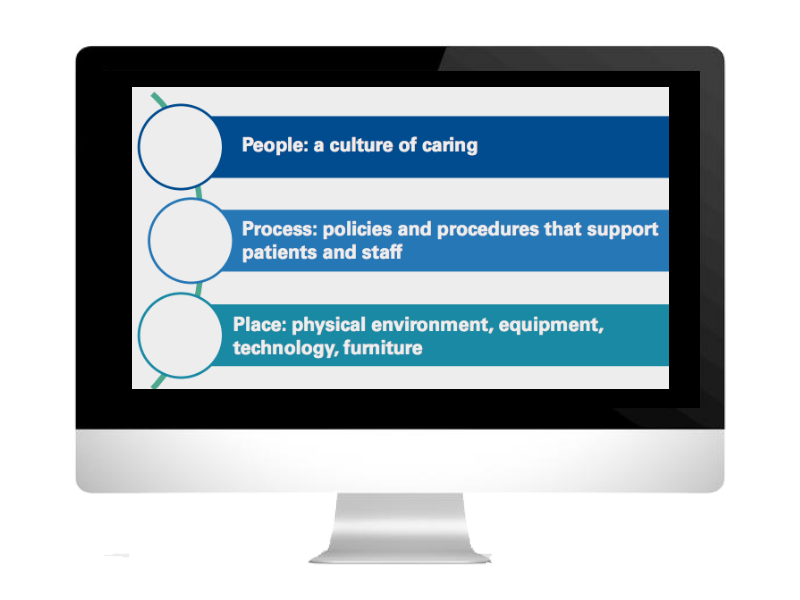Now more than ever, patients have become more like consumers and medical purchasing power has shifted from providers and insurers to individuals. This change has created a unique marketplace for healthcare services, emphasizing patient care and the physical environment's role in patient perception of the quality of care offered.
How to Improve Patient Satisfaction Through the Healthcare Physical Environment
Increasingly, the results of patient satisfaction surveys are publicly released, so potential patients can now access reviews of your health facilities before they decide to use your services. This shift has also had a significant financial impact.
How Changes in Healthcare Impact Facilities Management.
Thirty percent of Medicare and insurance reimbursement decisions are now intricately tied to patient satisfaction scores on the Hospital Consumer Assessment of Healthcare Providers and Systems (HCAHPS) survey used by the Centers for Medicare & Medicaid Services (CMS).
The Future of Healthcare Tech at HIMSS.
This means that a well-maintained healthcare physical environment is essential to improving the patient experience and facility satisfaction scores. Here, we discuss improving patient satisfaction through strategic Healthcare Facilities Management.

The Research
Research on the healthcare physical environment has examined the effects of architecture, interior design, furniture placement, art, lighting, building materials, building systems, and maintenance programs on the patient experience.
More than 600 studies have linked the hospital environment to patient satisfaction, stress, health outcomes, and overall healthcare quality. By addressing multiple factors influencing the patient experience and using evidence-based design, hospital, and health facility leaders can assert greater control over their organization’s HCAHPS scores.
Mergers and Acquisitions Impact Healthcare Facilities.
Patient satisfaction scores are now one of the most significant metrics for attracting and retaining patients, maximizing reimbursement, and achieving better outcomes. Hospitals and health systems can ensure a positive patient experience by providing well-maintained environments where people feel safe, comfortable, and confident in their care.
Challenges Facing Healthcare Facility Managers.
Beyond the quality of medical care, patient experience is hugely impacted by the quality of the healthcare physical environment, the management of facilities, and the maintenance of assets.
According to a report by the American Hospital Association (AHA) and the American Society for Healthcare Engineering (ASHE), patient experience comprises three important and related factors: people, process, and place.
Healthcare Facility Management Trends.
This indicates that care staff, patient-centered operations, and well-designed facilities are the keys to providing a best-in-class patient experience.
Implement the People, Process, Place Model
In its research report, the American Society for Healthcare Engineering (ASHE) recommends using the “people, process, place” model to address concerns about patient satisfaction.

For example, if the hospital facility team wants to improve quietness scores, it can implement this model using the following tactics:
- People: Take a team approach that recognizes every staff member as part of the care team.
- Develop a noise-reduction campaign, identify target goals and support a culture of caring.
- Process: Create policies that consider the impact on patients and staff.
- Create a cellphone use policy for visitors and supply patients with earplugs and TV headphones.
- Place: Consider how the physical environment affects the patient experience.
- Use sound-absorbing materials, eliminate overhead paging and maintain equipment to avoid squeaks.
Perception is Everything
ASHE's report emphasises patient perception of the healthcare environment as one of the top indicators that influence how a particular patient will rate his or her experience. Therefore, it is wise to focus on controlling patient perception. For example, incorporating natural light and views of nature into hospital design can reduce the perception of pain, and providing successful wayfinding can contribute to higher overall ratings.
Healthcare Facilities Improvements.
Understanding the connection between a healthcare facility's physical appearance and patient satisfaction can have a lasting impact on a hospital's performance and its ability to provide exceptional community health.
Patients spend less than 1 percent of their time in the lobby, yet hospitals spend a large percentage of their financial resources on improvements to the public entryway. In actual fact, patients spend 99 percent of their time in areas that include inpatient rooms, operating rooms, outpatient clinics, exam and procedure rooms, and support areas.
Healthcare Facilities Condition Assessment.
In addition, other non-clinical areas like public circulation, elevator banks, check-in and reception counters, and administrative areas contribute to the patient's perception. Shifting your improvement efforts from the lobby to patient rooms will positively impact patience experience and satisfaction.
Leverage Technology to Transform Your Process
- Develop a data-driven preventive maintenance plan which will reduce the amount of deferred maintenance
- Use a digital work order system for improved communication and insight on your team's work
- Implement a digital and mobile asset management system for effective capital planning
Foundation Condition Assessment and Capital Planning Systems for Healthcare
Improving key details can make a big impact on your healthcare institution's next HCAHPS survey. Focus on areas such as proper lighting, quality doorways and corridors, functioning medical equipment and noise levels. Patients take in all of these factors when they evaluate their care experience.
Schedule a demo today to learn more about improving patient satisfaction through the physical environment of healthcare. Discover how our strategic Healthcare Facilities Management solutions can help you enhance the patient experience and boost satisfaction scores. Take the first step towards creating a well-maintained and patient-centered healthcare environment.
---
Sources
D'Angelo, John and Sue Pi. "How Healthcare Facilities can Improve Patient Satisfaction," Facilities Net, https://www.facilitiesnet.com/healthcarefacilities/article/How-Healthcare-Facilities-Can-Improve-Patient-Satisfaction-Facilities-Management-Health-Care-Facilities-Feature--14875.
Eagle, Amy. "Building Patient Satisfaction," HFM Magazine, https://www.hfmmagazine.com/articles/2314-building-patient-satisfaction.
Ferenc, Jeff, "Study tests one way to change patient room design and satisfaction," HFM Magazine, https://www.hfmmagazine.com/articles/2342-study-tests-one-way-to-change-patient-room-design-and-satisfaction.
Kenney, Lynn, "HCAHPS Scores, the Patient Experience, and the Affordable Care Act from the Facility Perspective," American Society for Healthcare Engineers (ASHE), http://www.ashe.org/management_monographs/mg2015kenney.shtml.
Kenney, Lynn and Deanna Martin, "Improving the Patient Experience Through the Health Care Physical Environment," American Hospital Association (AHA) and American Society for Healthcare Engineering (ASHE), http://www.ashe.org/management_monographs/pdfs/HPOE-Guide-on-the-Patient-Experience.pdf.
Morgan, Jamie. "Physical Environments and High-Quality Care," HFM Magazine, https://www.hfmmagazine.com/articles/3333-physical-environments-and-high-quality-care.
Martin, Deanna, "The Facility Manager's Role in Patient Satisfaction," HFM Magazine, https://www.hfmmagazine.com/articles/1880-the-facility-manager-s-role-in-patient-satisfaction.
Morgan, Jamie, "Design Impact on Patient Satisfaction," HFM Magazine, https://www.hfmmagazine.com/articles/1992-design-s-impact-on-patient-satisfaction.
Ulrich, R. and Zimring, C., "The role of the physical environment in the hospital of the 21st century: A once-in-a-lifetime opportunity," Report to the Center for Health Design, https://www.healthdesign.org/system/files/Ulrich_Role%20of%20Physical_2004.pdf.


